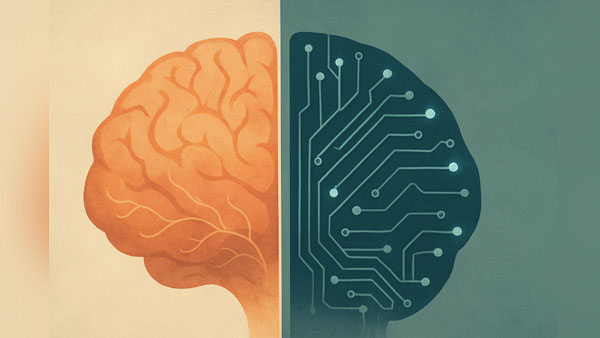By Satyabrat Borah
The human brain and artificial intelligence (AI) represent two fundamentally distinct systems for processing information and generating thought, each shaped by its unique design and purpose. The human brain, a biological marvel, operates through a complex network of approximately 86 billion neurons, interconnected by synapses that facilitate the flow of electrical and chemical signals. These connections enable humans to think, feel, imagine, and make decisions in ways that are deeply influenced by emotions, experiences, and environmental contexts. In contrast, AI, a product of human engineering, relies on computational algorithms, data processing, and predefined rules to analyze information and produce outcomes. While both systems can process information and solve problems, their approaches to thinking differ profoundly in terms of flexibility, creativity, emotional depth, and adaptability. Exploring these differences reveals not only the strengths and limitations of each but also the unique nature of human cognition and the potential of AI as a complementary tool.
Human thinking is a dynamic and multifaceted process. The brain integrates sensory inputs, memories, emotions, and cultural influences to form thoughts and make decisions. For instance, when a person sees a flower, their response is not limited to identifying its color or species. They might associate the flower with a memory, feel joy at its beauty, or even compose a poem inspired by its form. This ability to weave together sensory data, emotional responses, and abstract ideas is a hallmark of human cognition. The brain’s plasticity allows it to adapt to new situations, learn from experiences, and generate novel ideas, even in the absence of direct prior knowledge. This adaptability is evident in everyday scenarios, such as when a person interprets a friend’s tone of voice or facial expression to gauge their mood. Such intuitive understanding relies on subtle cues and contextual awareness, which the brain processes almost effortlessly through years of social and environmental learning.
AI operates on a foundation of data-driven computation. It processes vast amounts of information using algorithms trained on specific datasets to identify patterns, make predictions, or generate outputs. For example, an AI system can analyze an image of a flower, classify its species, and provide details about its characteristics with remarkable accuracy, provided it has been trained on relevant data. However, this process is purely analytical, devoid of emotional or subjective interpretation. AI does not “feel” the beauty of the flower or connect it to a personal memory because it lacks consciousness, emotions, or personal experiences. Its “thinking” is a series of calculations governed by mathematical models, optimized for speed and precision but limited by the scope of its training data. If an AI encounters a situation outside its training parameters it may struggle to respond accurately unless explicitly programmed or retrained to handle such cases.
One of the most striking differences between human and AI thinking lies in creativity. Humans possess an innate ability to generate original ideas, often drawing from seemingly unrelated experiences or concepts. This creativity is evident in art, literature, music, and scientific innovation, where individuals produce works that transcend their immediate knowledge or environment. For instance, a painter might create a surreal masterpiece inspired by a dream, or a scientist might propose a groundbreaking theory by connecting disparate observations. This capacity for novelty stems from the brain’s ability to engage in divergent thinking, where multiple possibilities are explored, often guided by intuition or emotional resonance. While AI can mimic creativity to an extent its outputs are fundamentally derivative. AI creates by recombining existing information in ways determined by its algorithms, not through genuine inspiration or emotional drive. A neural network trained to compose music, for example, might produce a melody that sounds Beethoven-esque, but it does so by analyzing patterns in Beethoven’s work, not by experiencing the emotional turmoil that fueled his compositions.
Another key distinction is the role of emotions in human thinking. Emotions profoundly shape how humans process information and make decisions. A person deciding whether to take a job offer might weigh not only logical factors like salary and location but also emotional considerations, such as how the job aligns with their passions or impacts their family. This emotional layer adds complexity to human decision-making, sometimes leading to choices that defy pure logic but resonate on a deeper, personal level. The brain’s limbic system, which governs emotions, interacts closely with the prefrontal cortex, responsible for reasoning, creating a feedback loop that integrates feeling and logic. AI, however, lacks this emotional dimension. Its decisions are based solely on optimizing predefined objectives, such as minimizing error or maximizing efficiency. Even when AI is designed to detect human emotions it does so by matching patterns in data, not by empathizing or experiencing emotions itself. This absence of emotional understanding limits AI’s ability to navigate situations where human judgment relies heavily on feelings or ethical considerations.
The human brain’s inefficiency, paradoxically, is one of its strengths. Humans make mistakes, forget details, and sometimes act irrationally, but these imperfections often lead to growth and innovation. Errors provide opportunities for learning, and moments of confusion can spark creative problem-solving. For example, a scientist’s failed experiment might lead to an unexpected discovery, or a writer’s struggle with a blank page might yield a unique narrative. AI, on the other hand, is designed for precision and consistency. It excels at tasks requiring speed, accuracy, and large-scale data processing, such as analyzing medical images or optimizing supply chains. However, when faced with ambiguity or scenarios beyond its programming, AI’s rigidity becomes a limitation. It cannot reflect on its mistakes in a human sense or draw inspiration from failure unless explicitly programmed to adjust its parameters based on feedback. Even then, this adjustment is a mechanical process, not a moment of insight.
Contextual understanding further separates human and AI thinking. Humans excel at interpreting situations within their broader context, drawing on tacit knowledge and social norms. For instance, a person can understand sarcasm or humor in a conversation because they grasp the speaker’s intent and cultural context. This ability stems from years of lived experience and socialization, which allow humans to navigate complex, nuanced interactions. AI struggles with such subtleties unless trained on extensive, context-specific data. Even advanced language models, which can generate human-like text, often misinterpret sarcasm or cultural references because they lack the lived experience that informs human understanding. Their responses are based on statistical probabilities derived from training data, not a genuine grasp of context or intent.
Despite these differences, there are areas where human and AI thinking converge. Both can process information, recognize patterns, and make decisions. AI’s ability to analyze massive datasets quickly complements the human brain’s slower, more reflective approach. For example, in medical diagnostics, AI can identify patterns in patient data that a doctor might overlook, while the doctor’s intuition and empathy guide patient care in ways AI cannot. This synergy highlights the potential for AI to augment human thinking rather than replace it. By handling repetitive, data-intensive tasks, AI frees humans to focus on creative, emotional, and strategic endeavors.
Looking ahead, advances in AI may narrow some of these gaps. Researchers are exploring ways to make AI more adaptive, context-aware, and even capable of mimicking emotional intelligence. Techniques like reinforcement learning and generative models are pushing AI closer to human-like flexibility, though they remain constrained by their reliance on data and computation. The human brain, with its billions of years of evolutionary refinement, remains unmatched in its ability to integrate sensory, emotional, and cognitive processes into a cohesive whole. Replicating this complexity would require not just technological breakthroughs but a fundamental rethinking of what it means to “think.”
The human brain and AI think in profoundly different ways, shaped by their distinct origins and purposes. The brain’s thinking is a rich tapestry of emotions, experiences, and creativity, capable of intuitive leaps and contextual understanding. AI’s thinking, while powerful and precise, is a mechanical process rooted in data and algorithms, lacking the emotional depth and spontaneity of human cognition. These differences underscore the unique strengths of each system: humans excel in creativity, empathy, and adaptability, while AI shines in speed, accuracy, and scalability. Together, they form a powerful partnership, with AI amplifying human capabilities rather than replicating them. Understanding these distinctions not only illuminates the nature of thought but also guides the ethical and practical development of AI in a world shaped by human values.




